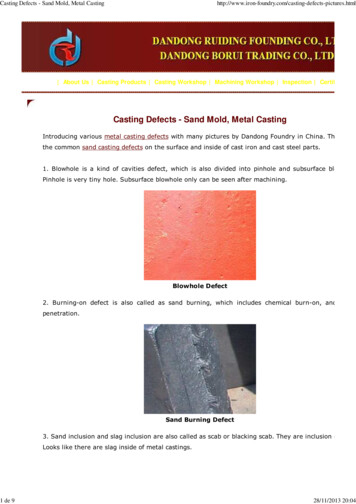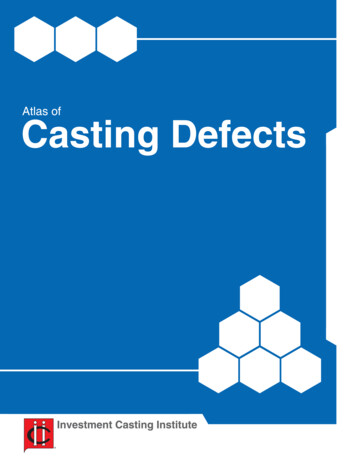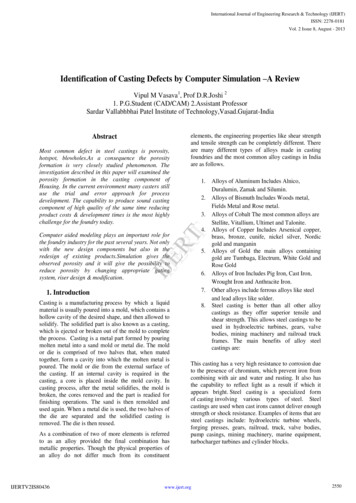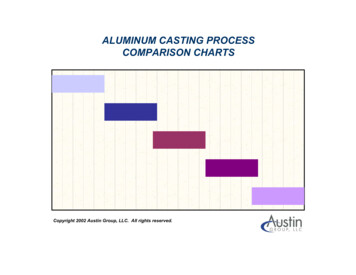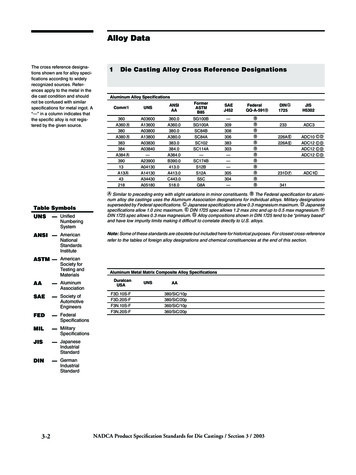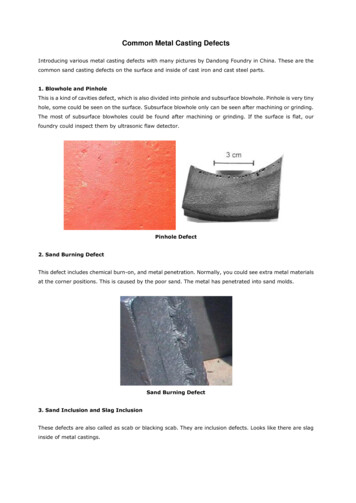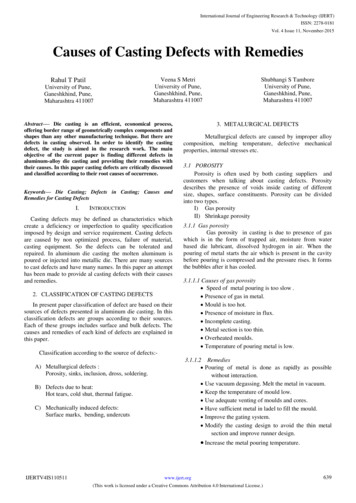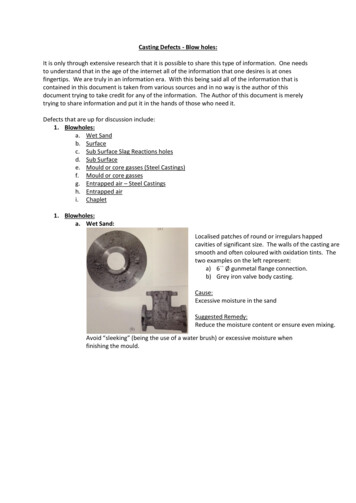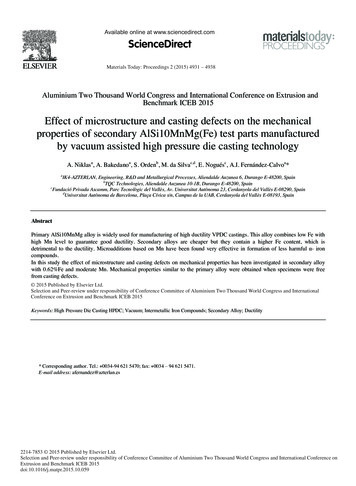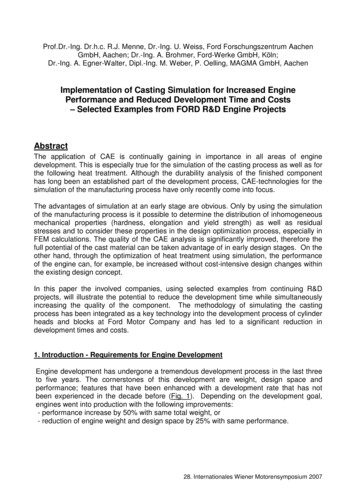
Transcription
-1Prof.Dr.-Ing. Dr.h.c. R.J. Menne, Dr.-Ing. U. Weiss, Ford Forschungszentrum AachenGmbH, Aachen; Dr.-Ing. A. Brohmer, Ford-Werke GmbH, Köln;Dr.-Ing. A. Egner-Walter, Dipl.-Ing. M. Weber, P. Oelling, MAGMA GmbH, AachenImplementation of Casting Simulation for Increased EnginePerformance and Reduced Development Time and Costs– Selected Examples from FORD R&D Engine ProjectsAbstractThe application of CAE is continually gaining in importance in all areas of enginedevelopment. This is especially true for the simulation of the casting process as well as forthe following heat treatment. Although the durability analysis of the finished componenthas long been an established part of the development process, CAE-technologies for thesimulation of the manufacturing process have only recently come into focus.The advantages of simulation at an early stage are obvious. Only by using the simulationof the manufacturing process is it possible to determine the distribution of inhomogeneousmechanical properties (hardness, elongation and yield strength) as well as residualstresses and to consider these properties in the design optimization process, especially inFEM calculations. The quality of the CAE analysis is significantly improved, therefore thefull potential of the cast material can be taken advantage of in early design stages. On theother hand, through the optimization of heat treatment using simulation, the performanceof the engine can, for example, be increased without cost-intensive design changes withinthe existing design concept.In this paper the involved companies, using selected examples from continuing R&Dprojects, will illustrate the potential to reduce the development time while simultaneouslyincreasing the quality of the component. The methodology of simulating the castingprocess has been integrated as a key technology into the development process of cylinderheads and blocks at Ford Motor Company and has led to a significant reduction indevelopment times and costs.1. Introduction - Requirements for Engine DevelopmentEngine development has undergone a tremendous development process in the last threeto five years. The cornerstones of this development are weight, design space andperformance; features that have been enhanced with a development rate that has notbeen experienced in the decade before (Fig. 1). Depending on the development goal,engines went into production with the following improvements:- performance increase by 50% with same total weight, or- reduction of engine weight and design space by 25% with same performance.28. Internationales Wiener Motorensymposium 2007
-2-Figure 1: Development trends regarding specific power output and displacementThe customer highly appreciates and honors these improvements, where especiallyresulting features like reduced gasoline consumption, crash security, and the overalldriving fun deliver high customer value. The next development goals are gasolineengines with 90 kW/L, 140 bar, and diesel engines with 80 kW/L, 200 bar, respectively.With this 'quantum leap' in engine development, companies are forced to break newground in many areas. However, these ambitious goals can not be met with commonprocedures. New processes and methods are required to successfully enter newterritory.2. Future Development ProcessThe general development targets have not really changed:- Reducing development times- Exploiting the potential of design and material- Reducing costs in the development process- Reducing component costs and production costsThe approach to support physical component tests with numerical processes hassuccessfully been used before and led to an extensive use of CAE in today's enginedevelopment process: Structural analysis (durability, acoustics/ NVH) Flow simulation (intake/exhaust gas system, in-cylinder flow, simulation of oilcirculation and water jacket, crank case/ PCV system) Dynamics of multibody systems (valve train, timing gear, crankshaft, piston) Simulation of friction and wear, bearing calculation28. Internationales Wiener Motorensymposium 2007
-3The individual CAE methods have reached such a quality and accuracy level that aspectslike production influences, tolerances, and parameter variation in production haveincreasingly more impact. Consequently, current CAE developments are mainly focusedon production processes: Failure hypotheses - considering local properties (microstructure, materialdefects, inhomogeneities) and more accurate material data (chemical composition,elevated temperatures) Manufacturing simulation - casting, forging, heat treatment, machining, joiningetc.This is the basis for the future development process: not only further development butintegration of CAE methods, i.e. a complete and Closed Loop CAE Procedure for thesimultaneous optimization of component and production process. This is the only way toreach the required quality level in the development process to achieve zero prototyping,substantially reducing development time as well as development costs (Fig. 2). At thesame time, the Closed Loop CAE Procedure together with the resulting improved analysisquality is the prerequisite to develop next generation high performance components.Figure 2: Resource shift following the Integrated CAE Development Process3. Casting Process Simulation for the Optimization of the Development ProcessAn important part of the zero prototyping development process for engine components isthe simulation of casting processes and heat treatment if applicable (Fig. 3). The objectiveis to identify the inhomogeneous distribution of material properties, residual stresses, theinfluence of component design, process parameters and their variations, and last but notleast the influence of the cast alloy. The simulation of the complete casting processprovides results like Hardness (required optimization parameter regarding the machining of iron castingsthat are of increasingly lightweight structure) Yield limit, tensile strength, SDAS, and further microstructural characteristics(important parameters for the component behavior under load as well as for failurelife calculations) Porosities (influence on function and fatigue life)28. Internationales Wiener Motorensymposium 2007
-4-Figure 3: Impact of casting and manufacturing processes on the component performanceResidual stresses are computed by simulating the casting or heat treatment process andare being implemented in the fatigue calculation as 'pre-load of the component'.The casting process simulation is easily integrated into the conventional CAE procedure.Due to the parallel integration the development process is not prolonged in spite of thesignificant quality improvements (Fig. 4).Figure 4: Integration of CAE and casting simulation28. Internationales Wiener Motorensymposium 2007
-54. FORD Engine Development - ExamplesThe potential of casting simulations covers all iron and nonferrous alloys as well as allcasting processes. Foundries use casting simulation on a regular basis for the optimizationof casting technology and production parameters. The objective is to avoid cold laps,porosities and inclusions, and in the case of cast iron components also to analyze themicrostructure for the calculation of hardness and yield point. The main parameter for CGI(compacted graphite iron) is nodularity (Fig. 5).Figure 5: Porosity and nodularity distribution (section) in a CGI blockAffected by the design, some areas cool down much faster than others leading to locallyincreased hardness values in cast iron (Fig 6). The simulation identifies this problemmaking it possible to respond as early as in the virtual development phase. Additionally,because of the high sensitivity of the MAGMA simulation it is possible to calculate theinfluence of alloy modifications even in the range of process variations. Consequently, theClosed Loop CAE Procedure is the way to identify the optimal alloy considering the locallyincreased hardness values.Figure 6: Hardness distribution and simulation sensitivity for GJLWhat is more, inhomogeneous cooling rates cause inhomogeneous mechanical properties(Fig. 7) that cannot be neglected in the new generation of high performance components28. Internationales Wiener Motorensymposium 2007
-6and hence need to be considered in the Closed Loop CAE Procedure. The challenge is tocombine production simulation and failure life calculations in an integrated CAE tool.Figure 7: Local mechanical properties and fatigue safety factor predictionThe zero prototyping development process adds the calculation and integration ofresidual stresses to the simulations that are traditionally rather foundry-relevant. Theresidual stresses in engine blocks are often as high as the assembly and operating loadsthemselves. However, the formation of residual stresses follows completely differentprinciples than the formation of thermal and mechanical operating stresses. Consequently,superposing these stresses does not only lead to increased stresses but also tocompensations, with the according impact on fatigue life.Figure 8: Impact of residual stresses on failure life predictionThe integrated CAE procedure includes residual stresses as the fourth load case withthe same importance as the three traditional load cases assembly, temperature, and peakpressure. The local mechanical properties are considered in the failure life calculations(Fig. 9).28. Internationales Wiener Motorensymposium 2007
-7-Figure 9: Integrated CAE procedureSlightly modified, this procedure is also used for cylinder heads and other heat treatedcomponents, where the dominant residual stresses are created during the quenchingprocess due to the significant temperature differences in the component (Fig. 10). Thesimulation considers the heat transfer in the quenching medium and the resulting coolingbehavior.Figure 10: Cooling curves and temperatures in a cylinder head during water quenchResidual stresses in high-strength heat treated cylinder heads are in some cases so closeto failure limit that prototype failure can already be explained with a simple residual stressanalysis. (Fig. 11). Thus, also for the consideration of heat treatment in the developmentprocess of high performance components, the integrated CAE procedure is indispensable.28. Internationales Wiener Motorensymposium 2007
-8-Figure 11: Test result and virtual residual stress analysis of a prototype cylinder headAluminum cylinder blocks with gray cast iron inserts show a similar picture. The residualstresses in the cylinder bridges are the reason for bridge cracks during machining. Theappropriate actions to address the bridge cracks can be taken during the productionprocess development. However, residual stresses will still be present in the componentand will have an impact on the fatigue life of these future high performance engines (Fig.12). Consequently the integrated CAE procedure is essential for the development of highlystressed aluminum engine components, whether they are heat treated or not. This isespecially true when dealing with hybrid components.Figure 12: Impact of residual stresses on total stresses during engine operationAnother topic is the use of a virtual DoE (Design of Experiment) for the development ofnew technologies. The robust design of aluminum crank cases with cast iron cylinder linerinserts requires e.g. to address the following tasks: Optimum wall thickness ratio of liner and bore bridge Controlled preheating of the liners in the core package or a high pressure diecasting die. Using the appropriate casting parameters to avoid cold laps28. Internationales Wiener Motorensymposium 2007
-9 Securing optimum heat transfer at operating temperature with the aluminum shrinkon processEnsure sealed bond between liner and aluminum structureCompared with the 'conventional' process that includes various process steps like design,trial castings, analysis of prototypes, engine tests, and pulser tests, including thenecessary optimization loops covering the whole process, the new Closed Loop CAEProcedure is much quicker and more efficient: Designing geometry for minimum wall thicknesses Strength calculation and casting simulation Optimization loops with repeated calculation of strength, casting properties, andresidual stresses Producing prototype components Verifying design in engine trials and pulser testsCasting simulation does not only deliver all relevant information for the layout of designand process (Fig. 13); it now represents a powerful and robust feature that allows the useof a virtual DoE to analyze the interdependencies of its parameters. Not only thesignificantly reduced development times and costs, but also and especially the extendedgained knowledge regarding component load capacity as well as process sensitivity canbe seen as important advantages providing a considerably improved basis for futuredevelopments.Figure 13: Casting simulation supporting new technologies28. Internationales Wiener Motorensymposium 2007
- 10 5. Potential for the Development ProcessThe previous chapter demonstrates the integrated CAE procedure as a powerful andeffective tool to reduce development time and costs as well as to optimize quality. Thisapplies to new technology concepts as well as to product development.The main potentials for quality improvements and cost savings are: casting trials (filling,solidification, cold laps, porosities), prototype manufacturing, component and materialanalyses (residual stresses, properties), test runs including result evaluation, machiningtrials (hardness, cracks), and last but not least the definition of robust productionparameters (casting parameters, alloys, insert temperatures).5.1. Developing New Technologies With Minimum EffortThe integrated CAE procedure provides significant advantage in the advanced designphase for concept studies as part of the development of new technologies. In the past,this applied to the development of iron inserts, alternative heat treatment processes, ormaterial substitutions. In the future, targets are more widespread topics, starting from thinwall castings via machining clamp loads and die lifetime up to alloy development.The saving potential is explained in the complete substitution of the experimental DoE witha virtual DoE. In the advanced design phase the time for technology development can bereduced down to 50% - 25% of the normal time and costs can be reduced by up to50 % due to omitting extensive work for sample production and machining, for tests, andfor component checks.The distinctive feature of the virtual DoE is the ability to address bigger developmentsteps regarding design, material, and process, which is due to the fact that a much highernumber of parameters can be considered including the influence of theirinterdependencies.5.2. Reducing Engine Product Development Times and CostsThe first step to introduce the integrated CAE procedure into product development is theconsequent parallelization of component CAE and manufacturing simulation. Thismeasure already reduces the development time by ca. 3 months, as the development ofcasting prototypes can be finished in time with the last design step. The increased effortfor simulation and coordination during the simultaneous optimization creates additionalcosts; however, these costs are more than compensated by the early consideration ofproduction related influences and the reduced effort for test bed runs. Further developmentfocuses on the completion of material data and models for the whole range of appliedmaterials.28. Internationales Wiener Motorensymposium 2007
- 11 The second step is the total substitution of the physical prototypes and their related testbed runs with virtual prototypes in the series-1-phase (Fig. 14). The result is the reductionof engine development time by approximately 6 months as well as the correspondingcost reduction with synergy effects having impacts on several process steps includingengine machining. The challenge here is shifting the core engineering resources towardsCAE evaluation.Figure 14: Savings in development time due to integrated CAE processes28. Internationales Wiener Motorensymposium 2007
- 12 6. ConclusionThe comprehensive integration of manufacturing process simulation into the engine CAEdevelopment procedure (Fig. 15) is the key to success for the accelerated realization ofengine downsizing and increased performance that comes along with a reduction indevelopment time and costs at the same time. It is the prerequisite for zero prototyping.Our examples show the tremendous opportunities in the integrated CAE procedure,exceeding by far the savings achieved by the general and more traditional approaches.The result of this concept is like a 'breakthrough' that has rarely happened before in enginedevelopment and that will prove to be a cornerstone for all future developments.Figure 15: Integrated CAE process applied to engine development28. Internationales Wiener Motorensymposium 2007
With this 'quantum leap' in engine development, companies are forced to break new ground in many areas. However . temperature, and peak pressure. The local mechanical properties are considered in the failure life calculations (Fig. 9 ). . The main potentials for quality im
